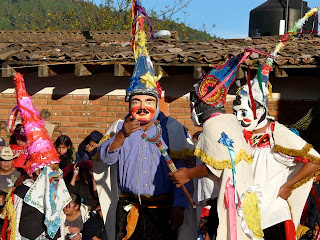
In several post I have described the dance of the Moors and provided my attempts to understand the importance of this dance. I now have a better handle on the dance and attempt to clarify my earlier interpretations here.
The first thing to know is that Santiago is the Patron saint of Spain and of Mexico. Santiago (or Santo Diego), Saint James in English, was one of the original apostles. Apparently he preached in Spain before returning to die in Jerusalem. His bones, however, were returned to Spain but not until about 800 AD and the famous pilgrimage route ends at the church built over his remains. The church was built in the early 800s and for 1000 years people have been walking this pilgrimage route. The second thing to know is that for several centuries the Moors, or Muslims, ruled Spain as well as parts of northern Africa. The Christians began to retake Spain around 800BC but did not complete this task until about 1490 with the capture of Granda, one of the most beautiful spots in the world, shortly before the discovery of Mexico. In the early days of the battle to drive out the Muslims a legend was developed that appears to have little foundation but it goes as follows. After being defeated by the Moors the Christian troops were regrouping when their leader had a dream in which a knight on a white horse with a sword in his hand appeared telling him that the Christians would be victorious. With this encouragement the troops returned to the field and were indeed victorious. The story claims that the knight in this vision was Saint James and he is now depicted on a horse with sword in hand and often with dying Moors at his feet. He became known as Santiago Matamoros, which in English means Saint James the Moor killer. You can find many images of Santiago in churches throughout Mexico.
So the Moors were important to the legend of Santiago, the patron saint of Mexico and for many years a dance depicting the battle between Christians and Moors was performed. As said in earlier posts this battle was important in a country were Christians were sent to convert “heathens” much as they had done with the Muslims. So the dance depicts the power of the Christian establishment and the senselessness of resisting. The most common dance today is the "half conquest", a representation of the conversion of Muslims to Christianity not the battle fought by Santiago. However, we do know that Muslims, Protestants and Jews did resist the Spaniards and it was for this reason that the Spanish Inquisition was established.
 |
| Poor resolution in photo but here we see the Moor dancing for the Virgin. |
 |
| This is the only time I have seen female Moors. |
To more fully understand this one needs an outline of the full dance. Although the dance has varied over the country some common elements are: Christian and Muslin troops approach each other, there is a period of negotiation between the two sides, as this fails the troops engage in combat and the tragic defeat of the Muslims follows. This tragedy is then made right by the Muslims being uplifted by their conversion to Christianity. The "half conquest" only depicts this last half - eliminating the tragedy and showing the faithfulness of the indigenous population to Christ and church.
 |
| These were Moors with a difference. Shot in Sevina. |
 |
| The Moors almost always have beautiful capes with religious imagery on the back. |
One wonders if the dancers or organizers continue to see these dances as being in part about Muslims or against Islam. I love to attend these dances for the beauty of some of the costumes but it is clear that you could not perform this in a multicultural society. The Muslim community would be outraged: they have not been assimilated to Christianity. The good news is that many Christian churches have begun to remove images of Santiago Matamoros, now realizing it is an insult to Islam. Others have suggested that in America the name be changed to Santiago Mataindios.
No comments:
Post a Comment